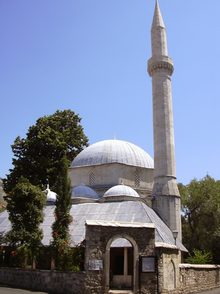|
Karađoz Bey Mosque
Karađoz Bey Mosque (Bosnian: Karađoz-begova džamija, Turkish: Karagöz Mehmed Bey Camii) is a 16th-century Ottoman mosque in the city of Mostar, Bosnia and Herzegovina. With its big dome and high minaret, it is one of the largest mosques in the region. HistoryAn Arabic foundation inscription on the mosque records that it was commissioned by Mehmed Beg b. Abu al-Saʿadat’ who was a brother of a vizier in the year AH 965 (1557–58). Some scholars have claimed that the vizier was the Ottoman grand vizier Rustem Pasha, but Rustem Pasha is recorded as having only one brother, Sinan Pasha.[2] The mosque may have been designed by the imperial architect Mimar Sinan. It is in the form of a domed cube fronted by a double portico. The three domes of the inner portico are supported by four marble columns. The outer portico has a shed roof resting on small octagonal pillars. The large 10.65 metres (34.9 ft) dome of the mosque sits on an octagonal fenestrated drum which is supported by eight-pointed arches.[2] The mosque was severely damaged during World War II, and faced near destruction during the Bosnian War in the early 1990s. However, Karađoz Bey Mosque, like the rest of Mostar, underwent extensive repairs between 2002 and 2004. The mosque was completely renovated and reopened to the public in July 2004. Bibliography
References
Wikimedia Commons has media related to Karadzozbey Mosque (Mostar). |
||||||||||||||||||||||||||||||||||||||||||||||||||||||||||||||

